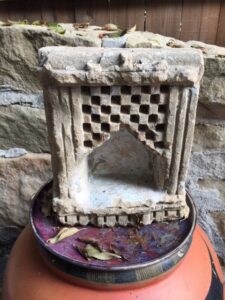 GT owns this little forty-eight-pound piece of stone, measuring nine by ten by eight inches. She thinks it might be related to a Hindu spiritual practice. Nobody at Goleta’s Habitat for Humanity ReStore, where she bought it, knew much about its origin. Indeed, it relates to Hindu spiritual practice, and the tradition goes back longer than anyone knows.
GT owns this little forty-eight-pound piece of stone, measuring nine by ten by eight inches. She thinks it might be related to a Hindu spiritual practice. Nobody at Goleta’s Habitat for Humanity ReStore, where she bought it, knew much about its origin. Indeed, it relates to Hindu spiritual practice, and the tradition goes back longer than anyone knows.
Specifically, GT’s altar is a 19th century sandstone niche, originally a form designed as part of a temple facade as a niche for oil lamp or candle. This tradition goes back to the 8th century. The form is called a Gokhas, still a part of life today. Traditional devotees in a modern Hindu home own one of these carved out of stone to insert in the wall in the garden to hold a candle or incense cone. These stone boxes are shrines. They repeat a square carving motif above the central arch in the style called Mudejar. GT’s is a 19th century carved stone niche Rajasthani altar with a value of $500-$800 today.
Why is a light in an ancient Hindu alter set in stone?
Why does the tradition of the tiny shrines for a god or goddess use STONE? From the earliest times gods of the Hindu tradition were venerated in candle lit stone caves called “the navels of the world.” So, the small altars, or tiny stone shrines, built into garden walls as late as the 19th or 20th century represented the tradition of the ancient natural cave environment.
Architects of veneration in the earliest centuries carved stones deep in the earth. They scooped out and carved from a rock face, leaving a mystery how they accomplished the great feat. Devotees of the later 18th, 19th, and 20th centuries carved these “mini” shrines, or ordered them carved, out of the rocks used to build a dwelling or a garden wall, usually out of sandstone. They meant these as a remembrance of the cave carvings of ancient days.
In the most limited of funding, such as in lower/middle class home, a homeowner might carve a shrine out of the stone blocks used to build the dwelling.
Why a doorway or niche?
Why should this small altar come in the shape of a doorway or niche, not more than twelve inches tall? Because doorways and niches lead to openings.
On GT’s little altar once set into a garden wall we see little squares caved in the “roof” of the altar. This imitates the stone rendering of the ancient wooden structure of an altar going back 2,000 years. It echoes screens called “jalis” in those sanctuaries meant to filter out the harsh light of the sun. They bring a quiet, solemn atmosphere to the interior where people venerated a god or goddess. The interlacing squares let some light through, some not. Filtered light, an important devotional tool, sets a stage meant to focus the attention on the other world, not the bright light of the world of NOW.
This reflects the attention the ancient carvers gave to figures and altars of stone by firelight. The depiction of perforated stone conveys this understanding of the division between the darkest matter (stone) and light.
Some material objects take us back years to a tradition echoed in the objects. GT’s altar is one of those remarkable objects. Such a treat to see it and such a great find to have found, GT.